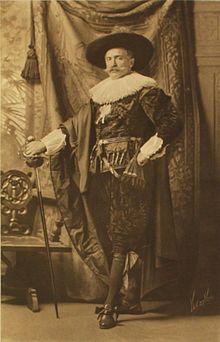
Yonker Ramp and His Sweetheart is an oil-on-canvas painting by the Dutch Golden Age painter Frans Hals, painted in 1623 and now in the Metropolitan Museum of Art, New York City. The painting has also been titled as Young Man and Woman in an Inn or Portrait of Pieter Ramp.
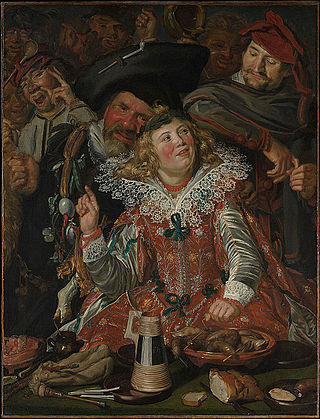
Shrovetide Revellers, also known as Merrymakers at Shrovetide, is a painting by the Dutch Golden Age painter Frans Hals, painted in around 1616–17. It is one of the earliest surviving works by Hals, and has been held by the Metropolitan Museum of Art, New York City since 1913. The painting shows people festivities at Shrovetide, an annual carnival of food and jollity which takes place before the Christian fasting season of Lent.

Claes Duyst van Voorhout is an oil-on-canvas portrait painting by the Dutch Golden Age painter Frans Hals, painted in 1638 and now in the Metropolitan Museum of Art, New York City.

Laughing Fisherboy is an oil-on-canvas painting by the Dutch Golden Age painter Frans Hals, painted in 1628 and now in Westphalia.

St. Mark is an oil-on-canvas painting by the Dutch Golden Age painter Frans Hals, painted in 1625. It was purchased by Russian philanthropist Alisher Usmanov from the art dealer Colnaghi, London in September 2013 for the Pushkin Museum and donated by him to that museum in November that year, where it still hangs.

Portrait of a Man in a Yellowish-gray Jacket is an oil-on-panel portrait painting by the Dutch Golden Age painter Frans Hals, painted in 1633 and now in the Staatliche Kunstsammlungen Dresden, Dresden.
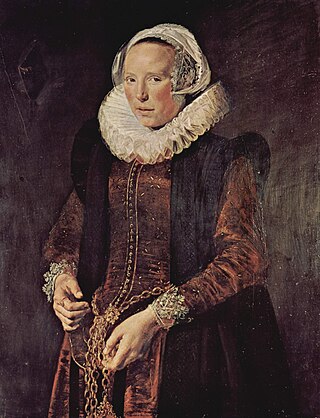
Portrait of a Woman Standing is a painting by the Dutch Golden Age painter Frans Hals, painted in 1610–1615 and now in Chatsworth House. It is considered a pendant portrait, but the sitter is unknown and therefore the pendant is not certain.
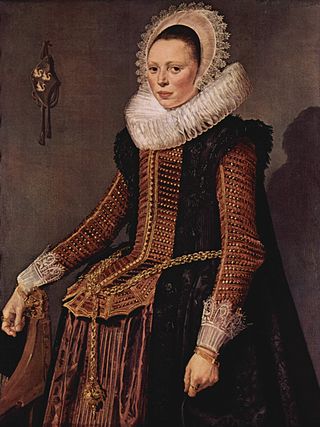
Portrait of a Woman Standing (Kassel) is a painting by the Dutch Golden Age painter Frans Hals, painted in 1618–1620 and now in Gemäldegalerie Alte Meister (Kassel). It is considered a pendant portrait to the Portrait of a Man Standing, in the same museum.

Catharina Both van der Eem is a painting by the Dutch Golden Age painter Frans Hals, painted in 1620 and now in Louvre Museum. It is considered a pendant portrait to the Portrait of Paulus van Beresteyn, in the same museum.
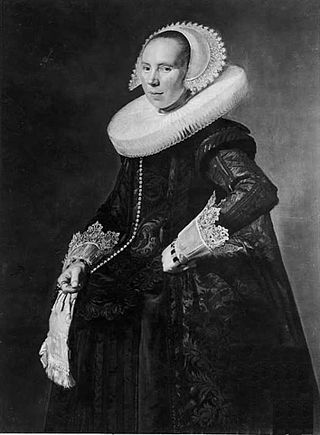
Portrait of Cunera van Baersdorp is an oil-on-panel painting by the Dutch Golden Age painter Frans Hals, painted in 1625 and now in a private collection. It is considered a pendant portrait to the Portrait of a Man Standing, now identified as Cunera's husband Michiel de Wael.

Portrait of a Woman in a Chair is an oil-on-canvas painting by the Dutch Golden Age painter Frans Hals, painted in 1627 and now in the Art Institute of Chicago. It is considered a pendant portrait, but the sitter is unknown and therefore the pendant is not certain.

Portrait of Cornelia Claesdr. Vooght is a painting by the Dutch Golden Age painter Frans Hals, painted in 1631 and now in the Frans Hals Museum. The painting is an oil on panel and is considered a pendant portrait to that of her husband, the Haarlem brewer and mayor Nicolaes Woutersz van der Meer.

Portrait of Catharina Brugmans is an oil-on-canvas painting by the Dutch Golden Age painter Frans Hals, painted in 1634 and now in a private collection. It is considered a pendant to the portrait of Catharina's husband Tieleman Roosterman.

Portrait of Sara Wolphaerts van Diemen is an oil-on-canvas painting by the Dutch Golden Age painter Frans Hals, painted around 1630–1633 and now in the Rijksmuseum, in Amsterdam. It is considered a pendant to the portrait of Sara's husband Nicolaes Hasselaer.

Portrait of Feyntje van Steenkiste is an oil-on-canvas painting by the Dutch Golden Age painter Frans Hals, painted around 1635 and now in the Rijksmuseum, in Amsterdam. It is considered a pendant to the portrait of Feyntje's husband Lucas de Clercq.

Portrait of Maria Pietersdochter Olycan is an oil-on-canvas painting by the Dutch Golden Age painter Frans Hals, painted in 1638, now in the São Paulo Museum of Art. It is considered a pendant to the portrait of Maria's husband Andries van Hoorn.

Portrait of Hylck Boner is an oil-on-canvas painting by the Dutch Golden Age painter Frans Hals, painted in 1635 and now in the Frick Collection. It is considered a pendant to the portrait of Hylck's husband Johannes Saeckma.
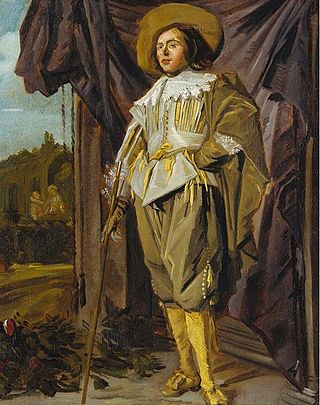
Standing Cavalier is a painting by Judith Leyster in the Royal Collection. It is the only painting by Leyster with a provenance that reaches back to the 18th-century.
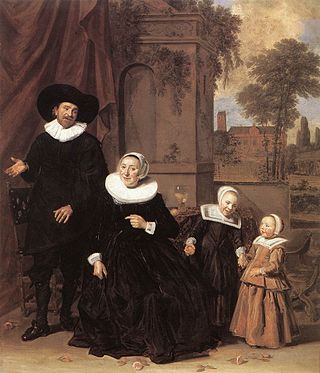
Portrait of a Dutch Family is an oil-on-canvas painting by the Dutch Golden Age painter Frans Hals, painted c. 1635 and now in the Cincinnati Art Museum, Cincinnati.

The Portrait of a Man in a Wide-Brimmed Hat is a work by the Dutch Golden-Age artist Frans Hals. It was painted in about 1625–1635 and hangs in the Herzogliches Museum, part of the Friedenstein Palace complex at Gotha, Germany. It was stolen in 1979, recovered in 2019, and restored in 2020–2021.


